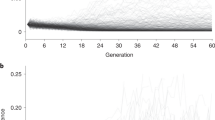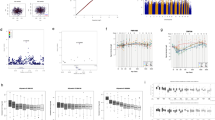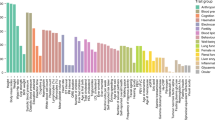Abstract
We have extended our analysis of the role of the long arm of the X chromosome (Xq28) in sexual orientation by DNA linkage analyses of two newly ascertained series of families that contained either two gay brothers or two lesbian sisters as well as heterosexual siblings. Linkage between the Xq28 markers and sexual orientation was detected for the gay male families but not for the lesbian families or for families that failed to meet defined inclusion criteria for the study of sex–linked sexual orientation. Our results corroborate the previously reported linkage between Xq28 and male homosexuality in selected kinships and suggest that this region contains a locus that influences individual variations in sexual orientation in men but not in women.
This is a preview of subscription content, access via your institution
Access options
Subscribe to this journal
Receive 12 print issues and online access
$209.00 per year
only $17.42 per issue
Buy this article
- Purchase on Springer Link
- Instant access to full article PDF
Prices may be subject to local taxes which are calculated during checkout
Similar content being viewed by others
References
Trip, C.A. The Homosexual Matrix. (Signet, New York, 1975).
Bell, A.P., Weinberg, M.S. & Hammersmith, S.K. Sexual Preference: Its Development in Men & Women. (Indiana University Press, Bloomington, 1981).
LeVay, S. The Sexual Brain. (MIT Press,Cambridge, MA, 1993).
Hamer, D.H. & Copeland, P. The Science of Desire. (Simon & Schuster, New York, 1994).
Hamer, D.H., Hu, S., Magnuson, V.L., Hu, N. & Pattatucci, A.M.L. A linkage between DNA markers on the X chromosome and male sexual orientation. Science 261, 321–327 (1993).
Pattatucci, A.M.L. & Hamer, D. Development and familiality of sexual orientation in females. Behav. Genet. 25, 407–420 (1995).
Putter, M. Psychiatric genetics: research challenges and pathways forward. Am. J. med. Genet. 15, 185–198 (1994).
Bailey, J.M. & PiIlard, R.C. A genetic study of male sexual orientation. Archs. gen. Psychiat. 48, 1089–1096 (1991).
Bailey, J.M. & Bell, A.P. Familiality of female & male homosexuality. Behav. Genet. 23, 313–322 (1993).
Bailey, J.M. & Benishay, B.A. Familial aggregation of female sexual orientation. Am. J. Psychiat. 150, 272–277 (1993).
Bailey, J.M., Pillard, R.C., Neale, M.C. & Agyei, Y. Heritable factors influence sexual orientation in women. Archs. gen. Psychiat. 50, 217–223 (1993).
Pillard, R.C. & Weinrich, J.D. Evidence of familial nature of male homosexuality. Archs. gen. Psychiat. 43, 808–812 (1986).
Pillard, R.C., Kinsey scale: is it familial? In Homosexuality/ Heterosexuality: Concepts of Sexual Orientation (eds McWhirter, D.R., Sanders, S.A. & Reinisch, J.M.) 88–100 (Oxford University Press, Oxford, 1990).
Kinsey, A.C., Pomeroy, W.B. & Martin, C.E. Sexual Behavior in the Human Male. (W.B. Saunders, Philadelphia, 1948).
Kinsey, A.C., Pomeroy, W.B., Martin, C.E. & Gebhard, P. Sexual Behavior in the Human Female. (W.B. Saunders, Philadelphia, 1953).
Kruglyak, L. & Lander, E.S. Complete multipoint sib-pair analysis of qualitative and quantitative traits. Am. J. hum. Genet. 57, 439–454 (1995).
Haseman, J.K. & Elston, R.C. The investigation of linkage between a quantitative trait and a marker locus. Behav. Genet. 2, 3–19 (1972).
Cardon, L.R. & Fulker, D.W. The power of interval mapping of quantitative trait loci, using selected sib pairs. Am. J. hum. Genet. 55, 825–833 (1994).
Fulker, D.W. & Cardon, L.R. A sib-pair approach to interval mapping of quantitative trait loci. Am. J. hum. Genet. 54, 1092–1103 (1994).
Fulker, D.R., Chemy, S.S. & Cardon, L.R. Multipoint interval mapping of quantitative trait loci using sib pairs. Am. J. hum. Genet. 56, 1224–1233 (1995).
Tran, L.D., Elston, R.C., Keats, B.J.B. & Wilson, A.F. Sib-pair linkage program In S.A.G.E. Users Guide, Release 2.2. (Department of Biometry and Genetics, LSU Medical Center, New Orleans, 1994).
Freije, D., Helms, C., Watson, M.S. & Donis-Keller, H. Identification of a second pseudoautosomal region near the Xq and Yq telomeres. Science 258, 1784–1787 (1992).
Kvaloyy, K., Galvagni, F. & Brown, W.R.A. The sequence organization of the long arm pseudoautosomal region of the human sex chromosomes. Hum. molec. Genet. 3, 771–778 (1994).
Lander, E.S. & Schork, N.J. Genetic dissection of complex traits. Science 265, 2037–2048 (1994).
Pericak-Vance, M.A. et al. Linkage studies in familial Alzheimer disease: evidence for chromosome 19 linkage. Am. J. hum. Genet. 48, 1034–1050 (1991).
Cardon, L.R., Smith, S.D., Fulker, D.W., Kimberling, W.J., Pennington, B.F. & DeFries, J.C. Quantitative trait for reading disability on chromosome 6. Science 265, 276–279 (1994).
Boehnke, M. Limits of resolution of genetic linkage studies: implications for the positional cloning of human disease genes. Am. J. hum. Genet. 55, 379–90 (1994).
Kruglyak, L. & Lander, E. High-resolution genetic mapping of complex traits. Am. J. hum. Genet. 56, 1212–1223 (1995).
Haqq, C.M. et al. Molecular basis of mammalian sexual determination: activation of Mullerian inhibiting substance gene expression by SRY. Science 266, 1494–1450.(1994).
Kruglyak, L., Daly, M.J. & Lander, E.S. Rapid multipoint analysis of recessive traits in nuclear families, including homozygosity mapping. Am. J. hum. Genet. 56, 519–527 (1995).
Wang, L.H., Collins, A., Lawrence, S., Keats, B.J. & Morton, N.E. Integration of gene maps: chromosome X. Genomics 22, 590–604 (1994).
Fisher, R.A. Statistical methods for research workers, 10th Edition. (Oliver & Boyd, Edinburgh (1954).
Author information
Authors and Affiliations
Rights and permissions
About this article
Cite this article
Hu, S., Pattatucci, A., Patterson, C. et al. Linkage between sexual orientation and chromosome Xq28 in males but not in females. Nat Genet 11, 248–256 (1995). https://doi.org/10.1038/ng1195-248
Received:
Accepted:
Issue Date:
DOI: https://doi.org/10.1038/ng1195-248
This article is cited by
-
Science, Scripture, and Sexuality: The US United Methodist Church at Crossroads
Journal of Religion and Health (2023)
-
Hormonal, Genetic, Immunological: An Array of Mechanisms but How Do They Interact, If at All?
Archives of Sexual Behavior (2023)
-
The gay gene(s)? Rethinking the concept of sexual orientation in the context of science
Biology & Philosophy (2022)
-
Genome-Wide Linkage Study Meta-Analysis of Male Sexual Orientation
Archives of Sexual Behavior (2021)
-
Discovery of new genetic loci for male sexual orientation in Han population
Cell Discovery (2021)



